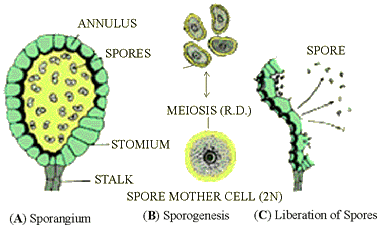|
PinkMonkey Online Study Guide-Biology
Asexual reproduction: As stated earlier, this takes place by spore formation. Spores are produced in sporangia which develop in sori.
Sporangium (Fig. 15.4A): Each sporangium has a
slender multicellular stalk and a body called capsule. The
capsule is oval or circular and flattened on two lateral sides like a
biconvex lens. The capsule wall is single layered and composed of thin-walled
cells. There is a ring of special cells in the wall that runs around the
capsule along its median edge. A major part of the ring is formed by the
annulus, in which cells have very thick inner walls. The remaining
part of the ring is called the stomium region. It is formed by
large, thin walled delicate cells. This ring plays an important role in
the liberation of spores.

Figure 15.4 Asexual reproduction
Each sporangium contains 16 diploid spore mother cells. These
divide by meiosis and produce 64 haploid spores
(n). Nephrolepis is homosporous. All spores are small and
kidney-shaped (Fig. 15.4B). The diploid sporophyte generation ends with
the meiosis.
Liberation of spores (Fig. 15.4C). The spores
are liberated from the capsule when the sporangium matures. The sporangium
(capsule) wall breaks open in the region of the stomium and the
spores are liberated through the opening. This is caused due to movements
of the annulus in hot and dry conditions.
Sexual reproduction: It takes place in the haploid gametophyte generation and involves the formation of specialized male and female sex organs.
Antheridium (Fig. 15.5). This is the male sex
organ. Antheridia develop on the lower surface of the prothallus in the
region of posterior margin among the rhizoids. Each antheridium is sessile.
It has a very small, delicate and globular body. The body wall is called
jacket. It is composed of only three cells: basal cup cell,
middle ring cell and apical cap cell. Antherozoids
are produced in each antheridium. These are haploid male gametes. Each
one has a spirally coiled body with many flagella. The wall of the mature
antheridium breaks open in the presence of water, and the antherozoids
are liberated on the moist soil.
|